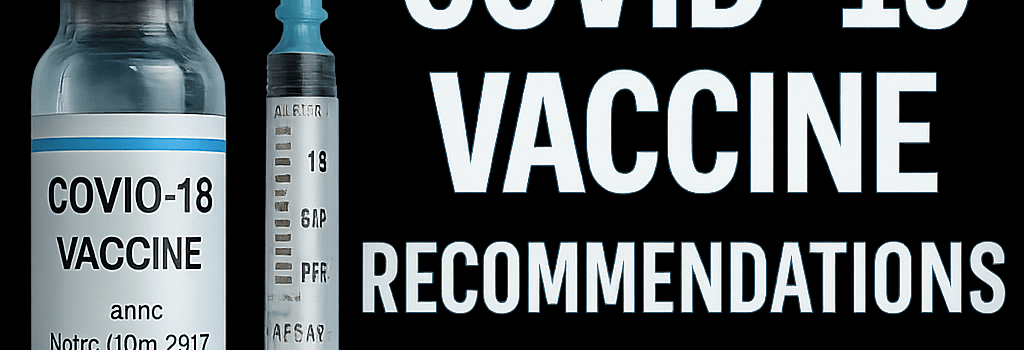CDC COVID-19 Vaccine Recommendations Update

Background and Timeline
On May 27, 2025, Health Secretary Robert F. Kennedy Jr. released a 58-second social media video declaring he had revoked CDC recommendations for COVID-19 vaccination in healthy children and pregnant individuals. The unilateral announcement, based on a one-page “secretarial directive” dated May 19, blindsided the Centers for Disease Control and Prevention (CDC) and contravened standard regulatory review by the Advisory Committee on Immunization Practices (ACIP).
Five hours elapsed before CDC officials confirmed receipt of the directive. On May 30, the agency partially updated the child/adolescent and adult immunization schedules, retaining technical vaccination pathways while adding caveats that dilute universal recommendations.
Key Changes in the Immunization Schedules
- Child & Adolescent Schedule: COVID-19 vaccination remains on the recommended schedule (CPT codes 91302–91304) but now requires explicit parental and provider agreement. Vaccinations outside physician offices (e.g., pharmacies) may need new consent forms.
- Adult Schedule (Table 2): Pregnancy is shaded gray, indicating “no guidance/not applicable.” A tooltip now advises, “Delay vaccination until after pregnancy if vaccine is indicated.” Previously, ACIP and FDA positioned vaccination during pregnancy as a high priority.
Technical Implications and Clinical Workflow
These changes reverberate through clinical information systems:
- Electronic Medical Record (EMR) Integration: Systems using HL7 FHIR immunization resources will need to update
ImmunizationRecommendationprofiles to reflect conditional recommendations. IT teams must revise clinical decision support (CDS) rules and consent workflows. - Vaccine Tracking (VTrckS & IIS): State Immunization Information Systems (IIS) rely on CDC’s electronic schedules. Altered guidance may trigger new triggers in VTrckS enrollment and eligibility flags.
- Insurance Billing and Coverage: Insurers follow the CDC schedule for mandatory coverage under the Affordable Care Act. Moving pregnancy guidance to “not applicable” could nullify coverage mandates, affecting CPT reimbursement and triggering payer policy revisions.
Regulatory Considerations and Insurance Impact
Under the Public Health Service Act, vaccines on the CDC schedule must be covered without cost-sharing. By removing an unambiguous, universal recommendation for pregnant individuals, insurers may classify COVID-19 vaccines under optional benefits. Blue Cross Blue Shield and Cigna are reportedly reviewing plan documents and may require preauthorization, potentially delaying access.
“We’re concerned that moving pregnancy off the recommended list undermines clear risk-benefit messaging and creates administrative barriers,” said Dr. Sara Oliver, lead CDC epidemiologist on maternal immunization.
Expert Analysis and Data Trends
Since 2020, peer-reviewed studies have shown that pregnant individuals have a 2–3× higher risk of severe COVID-19, including ICU admission and mechanical ventilation. A meta-analysis published in JAMA (April 2025) reported that vaccination reduced hospitalization risk by 85% and stillbirths by 22%.
“Delaying vaccination guidance during pregnancy contradicts robust safety monitoring data from v-safe and VAERS,” noted Dr. William Schaffner of Vanderbilt University Medical Center. “We need science-based public health policy, not shifting directives.”
Implementation Challenges in Clinical Settings
Clinics and pharmacies must revise standard operating procedures (SOPs). Potential hurdles include:
- Updating informed consent templates and electronic signature platforms.
- Training staff on new CDC guidance and state-level interpretation.
- Handling vaccine inventory management if demand drops or shifts location.
Data Interoperability and Reporting
Data sharing between EMRs, IIS, and federal agencies depends on consistent immunization schedules. A fragmented approach could introduce discrepancies in national vaccination dashboards and complicate public health surveillance, especially with emerging Omicron-subvariant lineages under FDA review.
Long-Term Public Health Impact
Experts warn that mixed messages may depress vaccine uptake among children and pregnant people, undermining herd immunity thresholds. The CDC reported 72% coverage for the primary pediatric series as of Q1 2025; even a 10% decline could increase community transmission and hospital strain during fall respiratory virus season.
Conclusion
While the CDC’s May 30 update preserves technical pathways for COVID-19 immunization, the added stipulations and removal of clear pregnancy guidance represent a policy shift with far-reaching clinical, regulatory, and public health consequences. Stakeholders across healthcare—IT, administration, payers, and frontline providers—must adapt swiftly to maintain vaccine access and safeguard vulnerable populations.